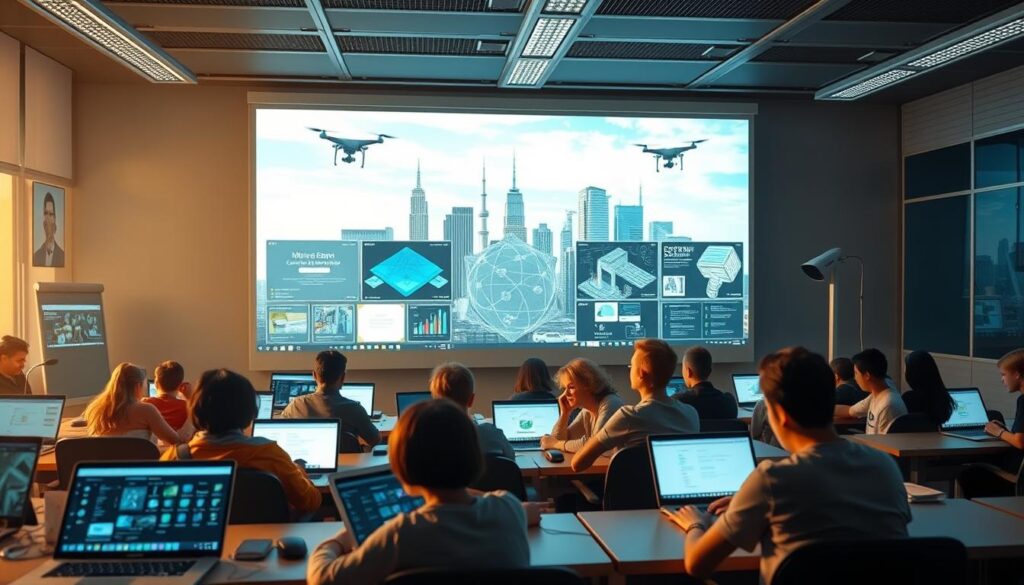The United States is on the cusp of a technological revolution, driven by innovations in STEM fields. According to the National Science Foundation, STEM education is a national priority, driving innovation and economic development.
As the world becomes increasingly dependent on technology and engineering, the importance of STEM education cannot be overstated. It shapes the future of individuals and the nation, opening doors to exciting STEM careers.
Key Takeaways
- Understanding the importance of STEM education is crucial for national development.
- STEM fields drive innovation and economic growth.
- A strong foundation in Science, Technology, Engineering, and Math is essential for future careers.
- STEM careers offer exciting opportunities for individuals.
- Investing in STEM education is vital for the future.
The STEM Revolution: Why It Matters
As we navigate the complexities of the 21st century, the importance of STEM education has never been more pronounced. The STEM revolution is not just about enhancing our understanding of science, technology, engineering, and mathematics; it’s about equipping future generations with the skills necessary to thrive in a rapidly evolving world.
The Origins and Evolution of STEM Education
The term STEM was first used in the 1990s, marking the beginning of a new era in education that emphasized the interconnectedness of these four disciplines. Since then, STEM education has undergone significant transformations, driven by advances in technology and the growing recognition of its importance in fostering innovation and economic growth.
The evolution of STEM education has been characterized by a shift towards more integrated and interdisciplinary approaches, aiming to provide students with a comprehensive understanding of how these subjects intersect in real-world applications. This evolution is crucial in preparing students for the challenges of the 21st century, where problems are increasingly complex and multifaceted.
The Growing Importance of STEM Literacy
STEM literacy is becoming essential for everyone, not just those pursuing careers in STEM fields. It enables individuals to make informed decisions about their health, finances, and civic engagement, among other aspects of life. Moreover, a population with high STEM literacy is better equipped to support innovation and competitiveness in the economy.
Key Benefits of STEM Literacy:
- Enhanced problem-solving skills
- Better career opportunities
- Informed decision-making
- Contribution to economic competitiveness
| Aspect | Pre-STEM Era | Post-STEM Era |
|---|---|---|
| Education Focus | Discipline-specific | Interdisciplinary |
| Skill Emphasis | Memorization | Critical Thinking |
| Economic Impact | Limited Innovation | Driven by Technology |
The STEM revolution is not just about education; it’s about building a more innovative and competitive society. As we continue to navigate the complexities of the 21st century, the importance of STEM education and literacy will only continue to grow.
Science, Technology, Engineering, and Mathematics: The Four Pillars Explained
The STEM fields are interconnected disciplines that form the foundation of a well-rounded education. Understanding the significance of each pillar is essential for appreciating the complexity of modern science and technology.
Science: The Pursuit of Understanding Natural Phenomena
Science is the systematic study of the natural world through observation, experimentation, and evidence-based reasoning. It encompasses various branches, including physics, biology, chemistry, and earth sciences, all of which contribute to our understanding of the world around us.
Key aspects of science include:
- Formulating hypotheses and testing them through experimentation
- Analyzing data to draw conclusions
- Developing theories that explain natural phenomena

Technology: Tools and Innovations That Shape Our World
Technology refers to the application of scientific knowledge to create practical solutions, tools, and innovations that transform our daily lives. It encompasses a broad range of fields, from information technology and biotechnology to nanotechnology and renewable energy.
The impact of technology is evident in:
- The development of new products and services
- The improvement of existing processes and systems
- The creation of new industries and job opportunities
Engineering: Designing Solutions to Complex Problems
Engineering involves the application of mathematical and scientific principles to design, develop, and optimize solutions to real-world problems. It encompasses various disciplines, including mechanical, electrical, civil, and chemical engineering.
Key aspects of engineering include:
- Identifying and analyzing complex problems
- Designing and testing innovative solutions
- Optimizing systems and processes for efficiency and effectiveness
Mathematics: The Language That Connects All STEM Fields
Mathematics is the study of numbers, quantities, and shapes, providing a fundamental language that underlies all STEM disciplines. It encompasses various branches, including algebra, geometry, calculus, and statistics.
The importance of mathematics lies in:
- Providing a common language for STEM fields
- Enabling the modeling and analysis of complex systems
- Informing decision-making through data-driven insights
By understanding the four pillars of STEM and their interconnectedness, we can appreciate the complexity and richness of these disciplines, driving innovation and progress in various fields.
The Current State of STEM Education in America
American STEM education is at a crossroads, with various initiatives and challenges emerging. The integration of science, technology, engineering, and mathematics into the educational framework has become a priority across the nation.
K-12 STEM Curriculum Development
The development of STEM curricula for K-12 students is a critical area of focus. Initiatives aim to make STEM subjects more engaging and accessible, fostering a strong foundation from an early age.
- Incorporating hands-on activities and project-based learning
- Emphasizing coding and computer science skills
- Promoting STEM education for underrepresented groups
Higher Education STEM Programs and Research
In higher education, STEM programs are being enhanced to meet the evolving demands of the industry. Research initiatives are also being bolstered to drive innovation.
| Program/Initiative | Description | Impact |
|---|---|---|
| STEM Research Grants | Funding for research projects in STEM fields | Advancing knowledge and innovation |
| Interdisciplinary STEM Programs | Combining multiple STEM disciplines | Fostering a holistic understanding of complex issues |
Government Initiatives Supporting STEM Education
The U.S. government has launched several initiatives to support STEM education, recognizing its importance for the nation’s future.
“Investing in STEM education is crucial for maintaining America’s competitive edge in the global economy.”
These initiatives include funding for STEM programs, development of new STEM curricula, and efforts to increase participation in STEM fields among underrepresented groups.
Essential STEM Skills for 21st Century Success
In today’s fast-paced, technology-driven world, possessing essential STEM skills is crucial for achieving success in the 21st century. A comprehensive STEM education fosters a positive STEM identity, enabling individuals to apply their knowledge to real-world problems effectively.
Critical Thinking and Analytical Reasoning
Critical thinking and analytical reasoning are foundational STEM skills that allow individuals to evaluate information, identify patterns, and make informed decisions. By cultivating these skills, individuals can navigate complex problems and develop innovative solutions. For instance, analyzing data trends and identifying causal relationships are critical components of analytical reasoning.
Problem-Solving and Design Thinking
Effective problem-solving and design thinking are essential STEM skills that enable individuals to approach challenges in a methodical and creative manner. By employing design thinking principles, individuals can empathize with users, ideate innovative solutions, and prototype effective answers to real-world problems.

Digital Literacy and Technological Fluency
In an increasingly digital world, possessing digital literacy and technological fluency is vital. This involves not only understanding how to use various digital tools but also being able to critically evaluate the information they provide. By staying abreast of emerging technologies, individuals can remain competitive in the job market and adapt to the ever-changing technological landscape.
Collaboration and Scientific Communication
The ability to collaborate effectively and communicate complex scientific concepts is critical in STEM fields. By working together and sharing knowledge, individuals can drive innovation and advance our understanding of the world. Effective scientific communication involves clearly articulating complex ideas and presenting information in an accessible manner, facilitating a broader understanding of STEM concepts.
The Power of Interdisciplinary STEM Approaches
The National Science Foundation’s emphasis on interdisciplinary research and education highlights the growing importance of integrated STEM approaches. By combining multiple STEM disciplines, individuals can develop a more comprehensive understanding of complex problems and create innovative solutions.
Breaking Down Boundaries Between Disciplines
Traditionally, STEM fields have been taught as separate entities. However, this siloed approach can limit the potential for cross-disciplinary connections and applications. Interdisciplinary STEM approaches aim to bridge these gaps by integrating science, technology, engineering, and mathematics into cohesive learning experiences.
For instance, a project that combines mathematical modeling with scientific inquiry and engineering design can help students develop a deeper understanding of complex systems. This integrated approach can foster a more nuanced understanding of the interconnectedness of STEM fields.
| Discipline | Key Concepts | Real-World Applications |
|---|---|---|
| Science | Natural phenomena, experimental design | Environmental conservation, health research |
| Technology | Digital tools, programming | Software development, data analysis |
| Engineering | Design principles, problem-solving | Infrastructure development, product design |
| Mathematics | Mathematical modeling, statistical analysis | Data-driven decision making, risk assessment |
Real-World Applications of Integrated STEM
The real-world applications of integrated STEM are vast and varied. From sustainable infrastructure development to medical technology innovations, the potential for interdisciplinary STEM approaches to drive positive change is significant.
By promoting interdisciplinary STEM education, we can empower future generations to tackle complex challenges and create innovative solutions. As the National Science Foundation’s emphasis on interdisciplinary research and education continues to grow, we can expect to see even more exciting developments in the field of integrated STEM.
Navigating STEM Career Pathways
With STEM occupations projected to grow significantly, exploring the various career pathways is essential for future success. The Bureau of Labor Statistics highlights the importance of understanding these emerging fields and their potential.
High-Demand STEM Fields in the US
The US job market is witnessing a surge in demand for STEM professionals, particularly in fields such as:
- Software development and programming
- Data analysis and science
- Cybersecurity
- Biotechnology and biomedical engineering
- Environmental science and renewable energy
These areas are not only driving innovation but also offering lucrative career opportunities.

Emerging Careers in Technology and Innovation
Beyond traditional STEM fields, new and emerging careers are making their mark, including:
| Emerging Career | Description |
|---|---|
| Artificial Intelligence/Machine Learning Specialist | Designing and developing AI and ML models for various industries |
| Cloud Computing Professional | Managing and maintaining cloud infrastructure for businesses |
| Internet of Things (IoT) Developer | Creating interconnected devices and systems for smart environments |
Salary Potential and Job Security in STEM
STEM careers are not only in high demand but also offer competitive salaries and enhanced job security. According to the Bureau of Labor Statistics, median salaries in STEM fields are significantly higher than the national average.
Preparing for the Future STEM Workforce
To thrive in the evolving STEM landscape, professionals must be adaptable, committed to continuous learning, and skilled in areas such as:
- Critical thinking and problem-solving
- Collaboration and communication
- Digital literacy and technological fluency
By focusing on these skills, individuals can position themselves for success in the dynamic world of STEM.
Addressing Diversity and Inclusion Challenges in STEM
Diversity and inclusion in STEM are not just moral imperatives but also essential for driving innovation and solving complex global problems. The lack of diversity in STEM fields has been a persistent issue, with certain groups being underrepresented.
Current Demographics and Representation Gaps
According to the National Science Foundation, women and underrepresented groups are significantly underrepresented in STEM fields. The data highlights a concerning trend where certain demographics are not adequately represented.
| Demographic Group | Representation in STEM |
|---|---|
| Women | 28% of total STEM workforce |
| African Americans | 9% of STEM workforce |
| Hispanics or Latinos | 10% of STEM workforce |
Barriers to Entry and Retention
Several barriers contribute to the underrepresentation of certain groups in STEM, including lack of access to quality STEM education, stereotypes, and biases. Addressing these barriers is crucial for creating a more inclusive STEM environment.
“To be successful in STEM, you need to be able to see yourself in the field. Representation matters, and it’s crucial that we work to create pathways for underrepresented groups to enter and succeed in STEM careers.”
Successful Initiatives Promoting Diversity in STEM
Various initiatives have been launched to promote diversity and inclusion in STEM. These include programs aimed at increasing access to STEM education for underrepresented groups, mentorship initiatives, and policies to foster a more inclusive work environment.
- Scholarships and financial aid programs for underrepresented students
- Mentorship programs connecting students with professionals in their desired field
- Inclusive hiring practices and diversity training in STEM organizations
By understanding the challenges and implementing effective solutions, we can work towards a more diverse and inclusive STEM community.
Accessing STEM Resources and Learning Opportunities
The landscape of STEM education is rich with opportunities for growth, from online platforms to professional networks. As the fields of science, technology, engineering, and mathematics continue to evolve, it’s crucial to identify the resources that support learning and professional development.
Online Platforms and Digital Learning Tools
The digital age has brought forth a plethora of online platforms and tools designed to enhance STEM education. Websites such as Khan Academy, Coursera, and edX offer a wide range of courses and tutorials. Interactive coding environments like Codecademy and GitHub provide hands-on experience for budding programmers. Moreover, virtual labs and simulations are revolutionizing the way complex scientific concepts are taught and understood.

STEM Workshops, Camps, and Competitions
Beyond the digital realm, numerous offline opportunities exist for STEM enthusiasts. Workshops and camps, often hosted by universities, museums, and private organizations, offer immersive learning experiences. Competitions like the Science Olympiad and MathCounts challenge students to apply their knowledge in practical, innovative ways. These events not only educate but also foster a sense of community among participants.
Scholarships and Financial Support for STEM Students
Pursuing STEM fields can be financially demanding, but various scholarships and financial aid programs are available. Government initiatives, corporate sponsorships, and institutional scholarships help alleviate the financial burden. For instance, the National Science Foundation (NSF) provides grants for STEM education, while many companies offer scholarships to students pursuing relevant fields.
Professional Organizations and Networking Resources
For those advancing in their STEM careers, professional organizations and networking events are invaluable. Groups like the Institute of Electrical and Electronics Engineers (IEEE) and the American Mathematical Society (AMS) offer conferences, publications, and networking opportunities. These platforms facilitate the exchange of ideas, collaboration on projects, and career advancement.
In conclusion, the array of STEM resources and learning opportunities is vast and diverse, catering to various needs and preferences. By leveraging these resources, individuals can enhance their STEM knowledge, skills, and professional standing.
Breakthrough Innovations Shaping the Future of STEM
The future of STEM is being shaped by groundbreaking innovations that are transforming our world. These advancements are not only revolutionizing existing technologies but also opening up new avenues for research and development. As we continue to push the boundaries of what’s possible, we’re witnessing significant breakthroughs in various STEM fields.
Artificial Intelligence and Machine Learning Applications
Artificial intelligence (AI) and machine learning (ML) are at the forefront of STEM innovations. These technologies are being applied across various industries, from healthcare to finance, enhancing efficiency and decision-making processes. AI-powered diagnostic tools are improving patient outcomes, while ML algorithms are helping to predict and prevent diseases.
The integration of AI and ML in STEM education is also on the rise. Educational platforms are leveraging these technologies to create personalized learning experiences, making complex concepts more accessible to students.
Biotechnology and Genetic Engineering Advancements
Biotechnology and genetic engineering are making significant strides, particularly in the field of medicine. Gene editing technologies like CRISPR are enabling scientists to develop new treatments for genetic disorders. Additionally, advancements in biopharmaceuticals are leading to more targeted and effective therapies.
These innovations are not only improving human health but also contributing to sustainable agricultural practices. Genetically engineered crops are being developed to be more resilient to environmental stresses, enhancing food security.
Renewable Energy and Sustainable Technologies
The shift towards renewable energy is a critical aspect of STEM innovations. Solar and wind energy technologies are becoming more efficient and affordable, reducing our reliance on fossil fuels. Energy storage solutions are also advancing, enabling better integration of renewable energy sources into the grid.
Sustainable technologies are being developed to address environmental challenges. Innovations in recycling technologies and waste management are helping to reduce our ecological footprint.
Space Exploration and Aerospace Innovations
Space exploration is experiencing a resurgence, driven by both government agencies and private companies. Reusability in launch systems is significantly reducing the cost of accessing space, while advanced propulsion systems are being developed to enable deeper space exploration.
Aerospace innovations are not limited to space exploration. Advances in materials science are leading to the development of lighter and stronger aircraft, improving fuel efficiency and reducing emissions.
STEM in Everyday Life: Practical Applications
From healthcare to transportation, STEM is making a significant impact on our everyday experiences. The fields of Science, Technology, Engineering, and Mathematics are not just abstract concepts; they are integral to the innovations that shape our daily lives.
Healthcare and Medicine
STEM applications in healthcare have led to groundbreaking advancements in medical technology and treatment options. For instance, the development of MRI and CT scans has revolutionized diagnostic medicine. Additionally, robotic surgery, enabled by engineering and technology, has improved the precision and outcomes of surgical procedures.
“The integration of technology and healthcare has the potential to significantly improve patient outcomes and reduce costs.” –
The use of data analytics and AI in healthcare is also becoming more prevalent, helping in predicting patient outcomes and personalizing treatment plans.
| STEM Application | Healthcare Impact |
|---|---|
| Medical Imaging Technology | Enhanced diagnostic capabilities |
| Robotic Surgery | Increased precision in surgical procedures |
| AI and Data Analytics | Personalized treatment plans and predictive analytics |
Transportation and Infrastructure
STEM is also transforming the transportation sector through innovations like electric vehicles, advanced navigation systems, and smart traffic management. These advancements are not only making transportation more efficient but also more sustainable.
Key Developments in Transportation:
- Electric and autonomous vehicles
- Advanced public transit systems
- Smart infrastructure for traffic management

Technologies in the Home and Daily Life
In our daily lives, STEM technologies are making homes smarter and more convenient. From voice assistants to smart home security systems, technology is enhancing our living experiences.
Examples of STEM in Daily Life:
- Smart home devices for energy efficiency
- Mobile apps for health and fitness tracking
- Online platforms for education and remote work
As we continue to embrace STEM in various aspects of our lives, it’s clear that these fields will play a crucial role in shaping the future.
Overcoming Challenges in STEM Learning and Advancement
The journey to mastering STEM subjects is often fraught with obstacles, but with the right strategies, learners can overcome these hurdles. According to the Office of STEM, building confidence and using effective study strategies are crucial for STEM success.
Building Confidence and Overcoming STEM Anxiety
Many students experience anxiety when faced with STEM subjects, which can hinder their ability to learn and succeed. Building confidence is key to overcoming this anxiety. Encouraging a growth mindset, where challenges are seen as opportunities for growth, can significantly impact a student’s ability to tackle complex STEM concepts.
Moreover, providing support systems, such as tutoring and mentorship programs, can help students feel more confident in their abilities. Positive reinforcement and acknowledging small achievements can also play a crucial role in building a student’s confidence in STEM subjects.
Effective Study Strategies for STEM Subjects
Developing effective study strategies is vital for success in STEM fields. This includes active learning techniques such as problem-solving, group work, and hands-on experiments. These methods not only enhance understanding but also make learning more engaging.
Additionally, time management and organizational skills are essential for keeping up with the demanding curriculum of STEM programs. Utilizing resources such as study groups and online tutorials can also supplement traditional learning methods.
Resources for Continuous Learning and Skill Development
In STEM fields, continuous learning is not just beneficial; it’s necessary. The rapid pace of technological advancements means that professionals must continually update their skills. Online courses and certifications offer flexible ways to achieve this, allowing individuals to learn at their own pace.
Furthermore, participating in workshops, conferences, and seminars can provide valuable networking opportunities and expose individuals to the latest developments in their field. Engaging with professional organizations can also offer resources and support for continuous learning and skill development.
The Global Impact of American STEM Leadership
The United States has long been at the forefront of STEM innovation, with far-reaching impacts worldwide. The country’s strong foundation in science, technology, engineering, and mathematics has enabled it to drive global advancements in various fields.

US Contributions to Worldwide STEM Advancements
American research institutions, industries, and government initiatives have significantly contributed to global STEM advancements. The US is home to many of the world’s top research universities and institutions, which attract talent from around the globe. These institutions have been instrumental in pushing the boundaries of knowledge in various STEM fields.
For instance, the US has been a leader in technological innovation, with Silicon Valley serving as a hub for tech giants and startups alike. American companies have pioneered advancements in areas such as artificial intelligence, cybersecurity, and data analytics, influencing the global tech landscape.
“The US has a unique ecosystem that fosters innovation, with a strong culture of risk-taking and entrepreneurship.”
International Collaboration in STEM Research
International collaboration is a hallmark of modern STEM research, with the US playing a significant role in global partnerships. American researchers and institutions collaborate with their counterparts worldwide to tackle complex challenges that require a concerted effort.
- Joint research initiatives between US and international institutions
- Global research networks and consortia
- International funding for STEM research projects
These collaborations not only advance knowledge but also help address global challenges, such as climate change, pandemics, and sustainable development.
Addressing Global Challenges Through STEM Innovation
American STEM leadership is crucial in addressing global challenges through innovative solutions. US researchers and companies are at the forefront of developing technologies and strategies to tackle some of the world’s most pressing issues.
For example, US-based companies and research institutions are leading efforts in renewable energy, sustainable technologies, and climate change mitigation. These innovations have global implications, contributing to a more sustainable future worldwide.
The global impact of American STEM leadership is undeniable, with far-reaching consequences for worldwide advancements and international collaboration.
Conclusion: Embracing the Future of STEM
The future of STEM is bright, with continued innovation and education shaping the world. As highlighted in the previous sections, STEM fields are driving advancements in technology, healthcare, and sustainability. The National Science Foundation and other organizations are working to promote STEM education and innovation, ensuring the US remains a global leader.
To fully harness the potential of STEM, it’s essential to continue investing in education and research. By fostering a culture of innovation and inclusivity, we can unlock the next generation of STEM leaders and breakthroughs. The future of STEM is not just about technological advancements, but also about creating a more equitable and sustainable world.
As we move forward, it’s crucial to prioritize STEM education, promote diversity, and encourage interdisciplinary approaches. By doing so, we can ensure that the future of STEM is shaped by a diverse and talented pool of individuals, driving progress and improving lives.
